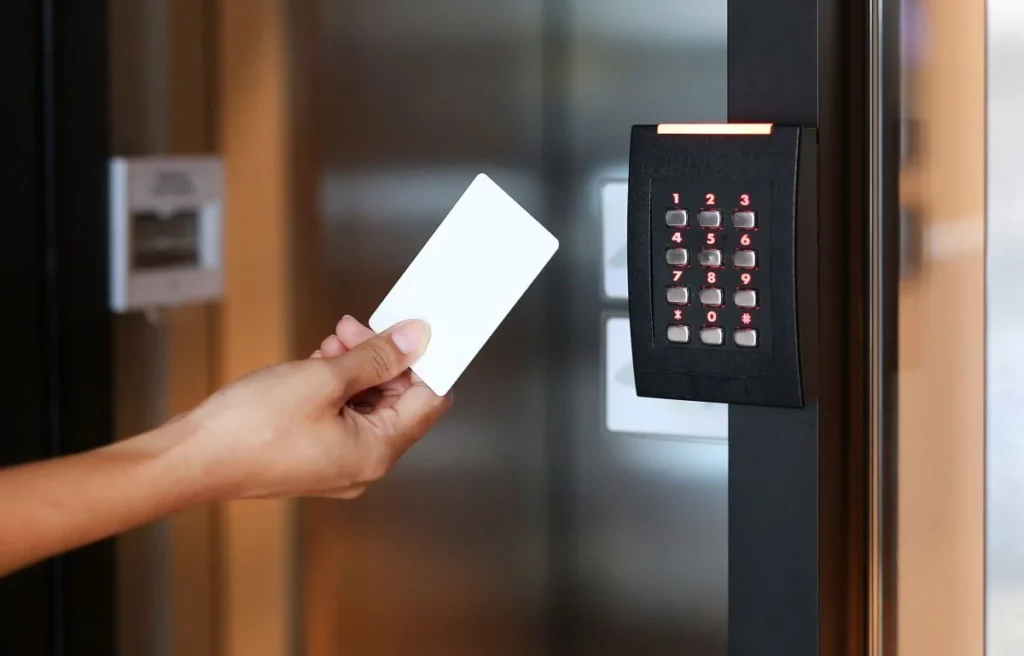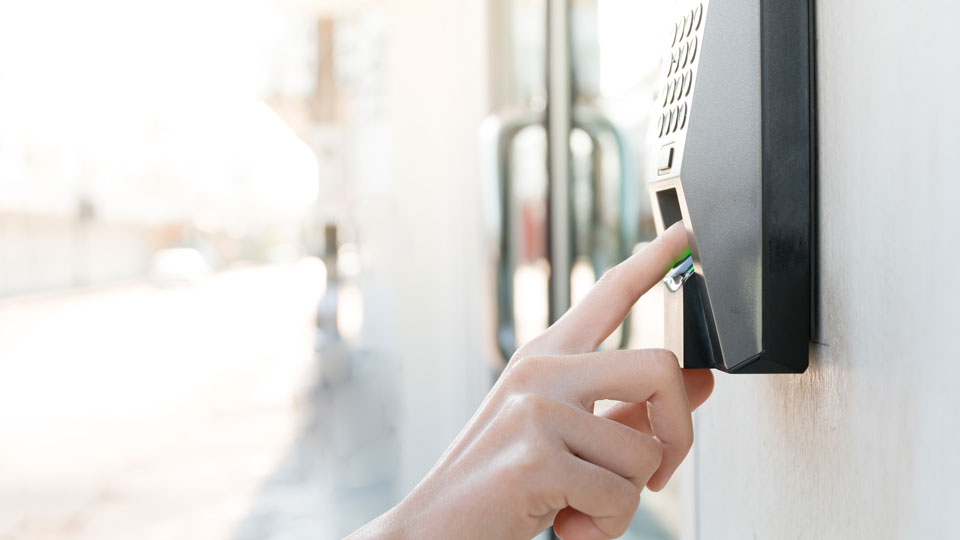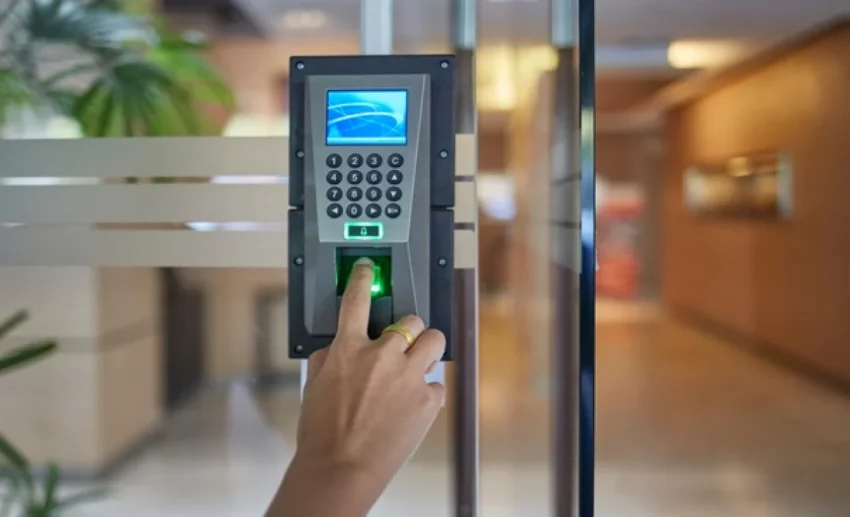Access control systems are the first line of defence in modern workplace security. They act as sophisticated gatekeepers, regulating and monitoring who can enter specific areas within a facility. These systems are a crucial part of physical security infrastructure, determining who can access what areas and when.
Access control systems offer several layers of protection:
- Restricted Area Management: Limiting entry to authorised personnel
- Activity Tracking: Recording movement patterns throughout facilities
- Risk Mitigation: Preventing unauthorised access to sensitive zones
- Emergency Response: Supporting swift evacuation procedures
These capabilities directly enhance workplace safety by creating controlled environments where threats can be identified and managed proactively. Access control systems work alongside other security technologies, such as CCTV surveillance, alarm systems, and back-to-base monitoring, to create an integrated security network that protects both assets and personnel.
By strategically placing access control points throughout a facility, organisations can establish clear boundaries. This helps them maintain compliance with safety regulations while also protecting employees, visitors, and valuable resources.
Understanding Access Control Systems
Modern access control systems offer diverse authentication methods to safeguard workplace premises. These systems range from basic to sophisticated technologies, each serving specific security requirements and operational needs.
1. Physical Credentials
- Swipe cards with magnetic strips or RFID technology
- Key fobs for contactless entry
- Traditional PIN keypads
- Smart cards with embedded microprocessors
2. Biometric Authentication
- Fingerprint recognition
- Retinal scanning
- Hand geometry readers
- Voice recognition systems
- Facial recognition technology
The implementation of multi-factor authentication adds robust security layers by requiring two or more verification methods. A typical combination might include:
- Something you have (access card)
- Something you know (PIN)
- Something you are (biometric data)
This layered approach significantly reduces security vulnerabilities and prevents unauthorised access through stolen credentials.
3. Touchless Access Solutions
The emergence of contactless entry systems has revolutionised workplace access control:
- Mobile credentials through smartphone apps
- QR code-based authentication
- Gesture recognition systems
- Long-range readers for hands-free entry
- AI-powered facial recognition
These touchless technologies not only enhance security but create a more hygienic workplace environment. Advanced systems can:
- Detect faces even with masks
- Process multiple entries simultaneously
- Integrate with thermal scanning
- Support contactless visitor management
- Enable remote access permissions
The selection of appropriate access control methods depends on various factors including:
- Security level requirements
- Number of access points
- User population size
- Budget constraints
- Environmental conditions
- Integration capabilities with existing systems
Modern access control platforms support customisation and scalability, allowing organisations to adapt security measures as needs evolve. These systems create detailed audit trails of all entry attempts, providing valuable data for security analysis and compliance requirements.
Enhancing Security by Preventing Unauthorized Access
Access control systems create strong barriers against security breaches by establishing clear boundaries between areas that are allowed and those that are restricted. These systems use detailed permission settings to limit access for personnel based on:
- Job roles and responsibilities
- Security clearance levels
- Time-based restrictions
- Authorizations specific to departments
The strategic placement of access control checkpoints greatly reduces security incidents through:
- Prevention of tailgating attempts (when someone follows an authorized person into a restricted area)
- Immediate detection of forced entry
- Automatic lockdown capabilities in case of emergencies
- Real-time access logs for tracking movements
Modern visitor management integrates seamlessly with access control through:
Digital pre-registration systems for visitors QR code-based temporary passes for quick entry Remote authorization protocols for approving access requests Automated check-in/check-out tracking for monitoring visitor movements
These advanced features have shown significant improvements in workplace security:
- 75% reduction in unauthorized entry attempts
- 60% decrease in reported theft incidents
- 40% fewer workplace accidents in restricted areas
The implementation of zone-based access restrictions creates multiple layers of security, turning vulnerable areas into protected spaces. High-security zones benefit from additional verification requirements, while visitor access remains streamlined yet secure through digital protocols.
Remote verification capabilities allow security personnel to monitor and authorize access requests from any location, ensuring consistent security standards across multiple entry points. This adaptation of the system proves particularly valuable for facilities with complex security needs or multiple access points that require simultaneous monitoring.
Integration with Other Security Systems for Comprehensive Safety
Access control systems are most effective when used in conjunction with other security technologies. By combining various security elements, we can create a powerful defence network that enhances safety in the workplace.
Benefits of Integrating Surveillance with Access Control
- Access logs paired with CCTV footage provide visual verification of entry attempts
- Automated camera focusing on specific entry points when access is granted
- Video evidence collection for security investigations
- Real-time visual monitoring of access points from a central location
Enhanced Coordination between Alarm Systems and Access Control
- Immediate alarm triggering for forced entry attempts
- Automatic door locking during security breaches
- Zone-specific responses based on threat detection
- Integration with fire safety systems for emergency evacuations
Monitoring Capabilities through Back-to-Base Communication
- 24/7 professional monitoring of all integrated systems
- Rapid emergency response coordination with authorities
- Real-time system health monitoring and maintenance alerts
- Remote troubleshooting capabilities
The integration of these systems creates a multi-layered security approach. When access control detects suspicious activity, surveillance cameras automatically focus on the area, while alarm systems stand ready to respond. This coordinated response enables security personnel to assess and address threats swiftly through back-to-base monitoring centres.
Smart system integration also enables automated responses to specific triggers. For example, when an unauthorised access attempt occurs, the system can lock down affected areas, activate nearby cameras, and alert security personnel simultaneously – all without human intervention.
Improving Emergency Preparedness and Response with Access Control Systems
Modern access control systems play a crucial role in emergency management plans. With their ability to track the location of individuals in real-time, security teams can quickly identify where everyone is within the building during a crisis. This level of accuracy is invaluable during evacuations, as it allows first responders to locate and assist anyone who may be trapped or injured.
How Access Control Systems Enhance Emergency Preparedness
1. Real-Time Location Tracking
Access control systems equipped with location tracking technology provide security teams with instant visibility into the whereabouts of personnel. This information is critical during emergency situations when every second counts.
2. Automated Notification System
In addition to tracking, access control systems also have automated notification capabilities. These alerts serve as an early warning system, immediately notifying security personnel of potential threats such as:
- Unusual access attempts at restricted areas
- Multiple failed entry attempts
- Doors held open beyond preset timeframes
- Unauthorized after-hours entry attempts
By promptly informing security teams about these incidents, they can take appropriate action to mitigate risks and ensure the safety of everyone involved.
3. Strengthened Evacuation Procedures
Access control systems contribute to more effective evacuation procedures through strategic management of control points. Some key features that enhance evacuation processes include:
- Automatic door release during fire alarms
- Emergency override capabilities for quick exits
- Designated evacuation routes through controlled access points
- Digital headcounts at assembly areas
These enhancements not only streamline evacuations but also help prevent bottlenecks and ensure that individuals are directed towards safe areas.
The Role of Data in Emergency Response
Another significant advantage offered by access control systems is their ability to generate detailed logs of all movement patterns. These records provide valuable insights into how people navigate through a facility during emergencies.
Security teams can analyse this data to identify potential weaknesses in their response plans and make necessary improvements. By understanding how individuals behave in crisis situations, organisations can better prepare themselves for future incidents.
Adaptability to Various Emergencies
Access control systems are designed to be flexible and adaptable, making them suitable for different types of emergencies. Whether it’s a security breach or a natural disaster, these systems can be configured to respond accordingly.
For instance, in the event of an active shooter situation, access control measures may include lockdown protocols that restrict movement within certain areas until law enforcement arrives. Similarly, during severe weather events like hurricanes or earthquakes, evacuation routes established through controlled access points can facilitate orderly departures from affected buildings.
Future Innovations in Access Control Technologies
As technology continues to evolve, so do access control solutions. The integration of artificial intelligence (AI) into these systems opens up new possibilities for threat detection and response.
With AI algorithms analysing data from various sources such as surveillance cameras and entry/exit logs, potential risks can be identified more accurately and swiftly. This proactive approach enables security teams to intervene before incidents escalate. For instance, the application of AI in cybersecurity could significantly enhance the effectiveness of access control systems by predicting and preventing potential cyber threats that could compromise physical security measures.
Furthermore, automated response protocols triggered by specific events (e.g., fire alarms) ensure timely actions without relying solely on human intervention. Such advancements hold great promise in enhancing workplace safety standards across industries
Promoting Hygiene and Health Safety in Workplaces with Touchless Access Technologies
The rise of health-conscious work environments has transformed traditional access control systems into sophisticated touchless solutions. Modern workplaces now prioritise minimising physical contact points to reduce the spread of pathogens and create safer spaces for employees.
Key Touchless Technologies:
- Face recognition systems
- Motion-activated automatic doors
- Mobile credentials via smartphones
- Gesture-controlled interfaces
These advanced technologies eliminate the need to touch shared surfaces like door handles, keypads, or card readers. Face recognition systems can authenticate personnel from a safe distance, whilst mobile credentials enable employees to use their smartphones as secure access tokens.
The implementation of touchless entry systems provides multiple health benefits:
- Reduced transmission of bacteria and viruses
- Decreased surface contamination
- Enhanced hygiene compliance
- Improved employee confidence in workplace safety
Post-pandemic workplace protocols have accelerated the adoption of contactless technologies. Many organisations now view touchless access control as essential infrastructure rather than optional upgrades. These systems support ongoing health initiatives by:
- Maintaining digital records for contact tracing
- Controlling occupancy levels in specific areas
- Enabling hands-free navigation throughout facilities
- Supporting social distancing measures
The integration of health-focused access technologies demonstrates a proactive approach to employee wellbeing, creating environments where safety and convenience align with modern health standards.

Streamlining Operational Efficiency and Workforce Management through Access Control Systems
Access control systems are powerful tools that make workplace operations smoother while keeping security standards high. These systems turn traditional ways of tracking time into automated processes that improve both efficiency and safety.
Automated Entry/Exit Logging
Access control systems automate the logging of entry and exit times, offering several benefits:
- No more manual sign-in sheets or paper records
- Less chance of mistakes in tracking attendance
- Accurate digital records for compliance purposes
- Ability to monitor how many people are in the workplace in real-time
The integration of access control with workforce management platforms creates a seamless system for:
- Tracking time and attendance
- Managing shifts
- Analyzing labour costs
- Allocating resources
- Processing payroll
Safety Through Efficiency
Access control automation also helps improve workplace safety in several ways:
- Preventing timecard fraud and buddy punching (when one employee clocks in for another)
- Ensuring accurate headcounts during emergencies
- Monitoring working hours to prevent incidents caused by fatigue
- Identifying unusual patterns of access that could indicate security risks
These systems also enable data-driven decision making through:
- Detailed reports on attendance
- Analytics on how space is used
- Tracking peak times when the workplace is most crowded
- Recognising patterns to optimise the flow of people within the workplace
The automation of workforce management processes through access control systems reduces administrative burden while strengthening security protocols. This dual benefit allows security personnel to focus on critical safety tasks rather than routine administrative duties.
Demonstrating Organisational Commitment to Employee Well-being with Access Control Solutions
Access control systems serve as a tangible demonstration of an organisation’s dedication to employee safety and well-being. The implementation of these advanced security measures creates a secure workplace environment where staff can focus on their tasks without safety concerns.
Research indicates that employees who feel protected at work demonstrate:
- Higher job satisfaction rates
- Increased engagement levels
- Reduced stress and anxiety
- Greater workplace loyalty
The visible presence of security measures, such as biometric scanners and card readers, sends a clear message that management prioritises staff protection. This investment in security technology builds a foundation of trust between leadership and employees.
A secure workplace environment powered by access control solutions creates psychological safety, enabling employees to:
- Take calculated risks in their roles
- Express ideas without fear
- Collaborate more effectively
- Focus on innovation and creativity
Access control systems also provide employees with personal autonomy through:
- Individual access credentials
- Customised security clearances
- Self-managed entry permissions
These personalised security features empower staff members while maintaining organisational security protocols. The resulting work environment combines professional freedom with robust protection measures, creating optimal conditions for both productivity and peace of mind.
Companies that implement comprehensive access control solutions often report strengthened employer-employee relationships and enhanced workplace culture, as staff members recognise and appreciate the investment in their safety and security.
Customising Access Control Solutions Based on Industry Needs
Different industries face unique security challenges that demand tailored access control solutions. A one-size-fits-all approach fails to address specific operational requirements and risk factors inherent to each sector.
Commercial Environments
- Multi-tenant office buildings require segregated access zones
- Reception areas need visitor management systems
- Parking facilities demand vehicle access control
- Retail spaces require after-hours security protocols
Industrial Settings
- Hazardous areas require strict authorisation protocols
- Heavy machinery zones need specialised safety interlocks
- Loading docks require automated gate systems
- Chemical storage areas demand enhanced monitoring
Strata Properties
- Common areas require resident-only access
- Package delivery systems need secure protocols
- Underground parking requires number plate recognition
- Pool areas need time-restricted entry
Professional security consultants play a vital role in system design by:
- Conducting thorough site assessments
- Identifying industry-specific risks
- Mapping traffic flow patterns
- Recommending appropriate technology solutions
- Creating scalable security frameworks
High-value sites often require additional layers of protection through:
- Mobile CCTV towers for temporary surveillance
- Perimeter detection systems with thermal imaging
- Advanced biometric verification
- Real-time monitoring stations
- Integrated alarm responses
The implementation of customised access control solutions ensures optimal security coverage while maintaining operational efficiency across different workplace environments.
Benefits Beyond Safety: Additional Advantages of Access Control Systems
Access control systems deliver substantial benefits that extend beyond basic workplace safety measures. Insurance providers recognise the risk-reduction value of these systems, often offering reduced premiums to businesses with comprehensive security installations. The presence of access control technology demonstrates a commitment to risk management, resulting in potential savings of 10-20% on insurance costs.
The integration of access control with surveillance systems creates a powerful evidence collection tool:
- Time-stamped entry records paired with CCTV footage
- Digital audit trails of all access attempts
- Detailed logs of security breaches or unusual activities
Remote management capabilities transform how businesses handle security operations:
- Real-time monitoring through smartphone applications
- Instant modification of access permissions
- Quick response to security incidents from any location
- Automated system health checks and maintenance alerts
These systems also streamline regulatory compliance by:
- Maintaining accurate records for workplace safety audits
- Documenting adherence to industry-specific security standards
- Supporting incident investigations with reliable data
The data gathered through access control systems serves multiple business functions, from optimising facility usage to improving emergency response protocols. This multi-faceted approach to security management creates value across various operational aspects while strengthening the organisation’s security posture.

Conclusion
Access control systems are a crucial part of modern workplace safety strategies. These integrated security platforms provide strong protection through multiple layers of physical security measures that protect both employees and assets. By using advanced access control technologies, businesses can precisely manage who has access to their premises, creating secure environments where staff can work without worrying about safety.
The impact of these systems goes beyond basic security functions:
- Strengthening business continuity by preventing potential threats
- Using data to optimise security measures
- Fostering a culture of safety awareness within organisations
The question of How Access Control Systems Can Improve Workplace Safety finds its answer in the seamless integration of cutting-edge technology with practical security needs. These systems continue to evolve, incorporating new innovations that address emerging workplace challenges while maintaining unwavering protection for personnel and property. The investment in advanced access control solutions represents a commitment to workplace safety that pays dividends in operational efficiency, employee confidence, and organisational resilience.
See Also: The benefits of installing an Access Control Door System in your office.

